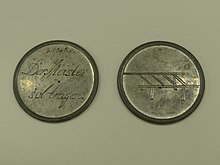Bricke
The Bricke is a word that is widespread in Low German but has fallen out of use and has two meanings:
On the one hand, in some places it denotes the edible fish river lamprey .
On the other hand, it named round (wooden) boards of various functions and sizes:
- Round, wooden cutting boards without indentations, as they were used from the Middle Ages to modern times as a plate substitute for meals. Representations of Jesus' Last Supper are an important visual source for the use of this table implement.
- Disc-shaped “stones” made of any material for board games ( mill , checkers ), also cited as Dambrikken .
- Wooden or pewter messenger signs, which an emissary from a corporation or a drawer of the dead brought to the addressee to be notified as a sign of loading or as an invitation to act as pallbearers (various examples from the late 18th century in the Focke Museum in Bremen).
- Disc-shaped float to cover the milk in milk buckets (including Bremen, 19th century).
- Wooden trailers for cattle were used in some places as proof of the right to graze.
proof
- ↑ so in Bremen, 16th century to 1832: small boards with branding of the Bremen coat of arms and year. (Heinrich Smidt: The Hollers and their ancestors , in: Johann Smidt, Der Familientag zur Dungen, 1867, p. 131)
literature
- Eberhard Tiling: Attempt of a Bremen-Lower Saxony dictionary. published by the Bremen German Society, Volume 1, Bremen: Förster, 1767.

